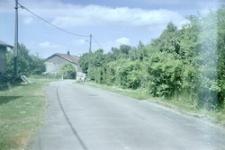|
Voigtlander Brillant V6 |
Manufactured or assembled in Germany from 1937 to 1938.
Index of rarity in France: Frequent (among non-specialized garage sales)
Inventory number: 11775
See the complete technical specifications
Chronology of cameras Voigtlander
The Voigtlander Brillant was introduced in 1932. Heavily inspired by the 1929 Rolleiflex, it is not, however, a true reflex camera, as its two lenses are not coupled, and there is no focusing verification in the viewfinder. Consequently, its selling price is much more reasonable than that of the Rollei.
The initial models used the lens/shutter block from the early Bessa models. The Brillant had a long lifespan and underwent several successive modifications, the most significant being the transition from using metal to bakelite for the camera body. There are numerous variations, as various shutters and lenses were used.
Depending on the lens, the focus setting is achieved by selecting a marker: Portraits, Groups, or Landscapes, or by following a graduated scale. In the early models, the front lens is fixed, and you have to adjust an index. Later on, the front lens itself needs to be turned.
The camera features an image counter (initially underneath the camera, later on the back) and protection against double exposures.
The camera can take 12 shots of 6 x 6 on a 6 x 9 film roll (120 format).
In 1937, Voigtlander introduced a new model called the Brillant V6. Apart from being made of bakelite, it introduced several new features such as a sports viewfinder, automatic film stop, and a filter compartment. Simultaneously, another model, the Brillant S, positioned itself at the top of the range with coupled lenses, providing a true reflex view. In the center of the viewfinder image, there is a ground glass circle for fine-tuning sharpness. It has a direct vision finder in the cap, as well as a magnifier. A light meter is included with this model.
| Years (c.) | TLR | Shutter | Lens | Focusing | |||
| Body made of metal | |||||||
| Brillant | 1932-38 | No | Voigtlander (1/25, 1/50, B, T) | Voigtar 7.7/75 mm | Focus using markers French version |
No | |
| Brillant |  |
1932-38 | No | Voigtlander | Voigtar 7.7/75 mm | Focus using markers French version |
No |
| Brillant |  |
1932-38 | No | Voigtlander | Voigtar 7.7/75 mm | Focus using markers Polish version |
No |
| Brillant | 1932-38 | No | AGC Embezet (1/25, 1/50, 1/100, B, T + Timer) | Voigtar 6.3/75 mm (3 lentilles) | Focus using markers British version |
No | |
| Brillant |  |
1933-38 | No | AGC Embezet | Voigtar 6.3/75 mm | Focus using markers French version |
Yes |
| Brillant | 1933-38 | No | F. Deckel Compur (1/300) | Skopar 4.5/75 mm (4 lentilles) | Graduated scale | Yes | |
| Brillant | 1933-38 | No | F. Deckel Compur-Rapid (1/500) | Skopar 4.5/75 mm | Graduated scale | Yes | |
| Body made of bakelite | |||||||
| Brillant V6 | 1937-51 | No | AGC Singlo (Timer) | Voigtar 6.3/75 mm | |||
| Brillant V6 | 1938-40 | No | AGC Singlo (Timer) | Voigtar 7.7/75 mm | |||
| Brillant V6 |  |
1938-40 | No | AGC Prontor II (Timer) | Voigtar 4.5/75 mm | ||
| Brillant V6 |  |
1937- 38 | No | F. Deckel Compur | Skopar 4.5/75 mm | ||
| Brillant V6 | 1938-40 | No | F. Deckel Compur-Rapid | Voigtar 4.5/75 mm | |||
| Brillant V6 |  |
1938-40 | No | F. Deckel Compur-Rapid | Voigtar 3.5/75 mm | ||
| Brillant V6 | 1950-52 | No | AGC Prontor II (timer) | Vaskar 4.5/75 mm | |||
| Brillant S | 1938 | Yes | F. Deckel Compur | Voigtar 4.5/75 mm | |||
| Brillant S | 1938 | Yes | F. Deckel Compur | Voigtar 3.5/75 mm | |||
| Brillant S | 1938-? | Yes | F. Deckel Compur | Skopar 3.5/75 mm | |||
| Brillant S |  |
1938-? | Yes | F. Deckel Compur-Rapid | Heliar 3.5/75 mm | ||
| Brillant S | 1938-? | Yes | F. Deckel Compur-Rapid | Skopar 3.5/75 mm | |||
In 1933, Photo-Porst catalogs mention a Voigtar 9/75 mm lens. In some English-speaking markets, the name "Brillant" is often referred to as "Brilliant."
Even after the production of the Brillant ceased, it continued to exist in the form of the Lubitel, a faithful Soviet copy, and many other similar cameras. __________
The Brillant V6 is the first Bakelite-made Brillant. There are two molds for it, as shown on page 97 of the 1938 Porst catalog. In one case, the compartment for storing filters is closed by a pivoting door, and the filters remain inside the compartment. In the other case, the door is hinged, and the filters are attached to the inside of the door. Unfortunately, the catalog does not specify whether these designs correspond to particular combinations of lenses and shutters.
After 1938, the version with the pivoting door disappears from catalogs and advertisements.
This version, with the pivoting door, has an exposure table on the side of the viewfinder cone.

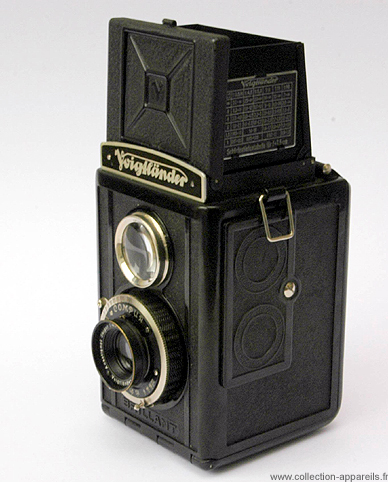
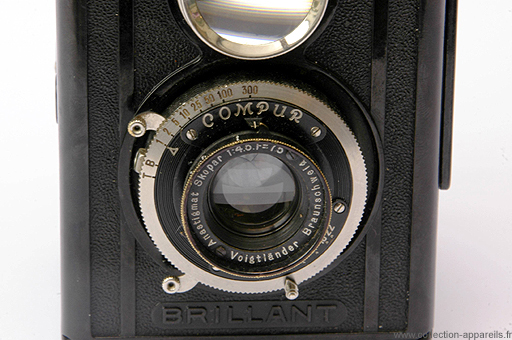
Interesting links or bibliography :
| Sur mes-appareils-photos.fr, suggested by Eric Carlhan |
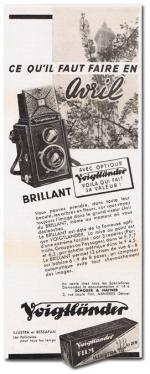 La photo pour tous de 1937 | 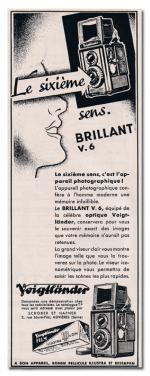 La photo pour tous de 1938 | 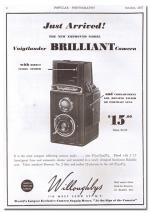 |  Popular Photography de 1939 |
Add a link or element of bibliography, a picture taken with this camera, a picture of box or an ads about this camera
Your photos taken with the same camera:
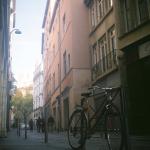
| 
| 
|
Cameras from Ebay France (Voigtlander) (Uploaded each 3 hours)







